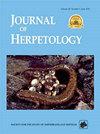Reaching New Heights: Arboreal Camera Trapping Provides New Insights on the Ecology of Gray Treefrogs (Hyla versicolor)
IF 0.8
4区 生物学
Q3 ZOOLOGY
引用次数: 0
Abstract
Abstract. The ecology of many arboreal ectotherms is poorly understood because of access constraints to the forest canopy. For example, despite their common name, Gray Treefrogs (Hyla versicolor) are understudied in arboreal habitats. Advancements in camera trap technology and tree-climbing techniques have created new opportunities to study arboreal species. Using arboreal camera trapping and time-lapse photography, we implemented the first study of H. versicolor behavior in the canopy. We examined seasonal and diel patterns of activity, microhabitat use, and effects of relative humidity and temperature on H. versicolor activity in eastern white pine (Pinus strobus) canopies. We installed camera traps at three research sites in northern Wisconsin, USA, spanning a 57-km north–south transect, and maintained them for multiple years. We detected H. versicolor events, of all sex–age classes, at two of our research sites. Use of time-lapse photography significantly improved our ability to detect H. versicolor in the canopy. Hyla versicolor individuals were active in the canopy every year of the study (2015–18), but predominantly during the summer, and peak diel activity occurred predominantly during the night (between 2100 and 2300 h). Hyla versicolor activity significantly increased as relative humidity and temperature increased. Hyla versicolor individuals were significantly more active in the upper canopy compared with other canopy locations and selected for the top side of branches. Our results highlight that H. versicolor frequent arboreal habitats of P. strobus canopies. Although further research is needed, our work lays a foundation of H. versicolor ecology within the canopy. This research also demonstrates the feasibility of using arboreal camera traps with time-lapse settings to study ectotherms in forest canopies.达到新高度:树栖照相机诱捕为灰色树蛙(Hyla versicolor)的生态学提供新见解
摘要由于受到进入林冠的限制,人们对许多树栖外食性动物的生态学知之甚少。例如,灰树蛙(Hyla versicolor)尽管有一个共同的名字,但对其树栖栖息地的研究却很不够。相机陷阱技术和爬树技术的进步为研究树栖物种创造了新的机会。利用树栖相机诱捕和延时摄影技术,我们首次对H. versicolor在树冠中的行为进行了研究。我们研究了东方白松(Pinus strobus)树冠中 H. versicolor 的季节和日间活动模式、微生境利用以及相对湿度和温度对其活动的影响。我们在美国威斯康星州北部的三个研究地点安装了相机陷阱,南北横断面长达 57 公里,并对其进行了多年维护。我们在其中两个研究地点发现了 H. versicolor 的活动,包括所有性别年龄级别。延时摄影的使用大大提高了我们在树冠层中发现 H. versicolor 的能力。在研究期间(2015-18年),Hyla versicolor个体每年都在树冠层中活动,但主要集中在夏季,活动高峰主要出现在夜间(21:00至23:00之间)。随着相对湿度和温度的升高,Hyla versicolor 的活动明显增加。与其他树冠位置相比,Hyla versicolor个体在树冠上部的活动明显更活跃,并且会选择树枝的顶端。我们的研究结果突出表明,Hyla versicolor经常栖息在石松树冠的树栖生境中。尽管还需要进一步的研究,但我们的工作为 H. versicolor 在树冠内的生态学奠定了基础。这项研究还证明了使用树栖相机陷阱和延时设置来研究森林树冠中的外温动物的可行性。
本文章由计算机程序翻译,如有差异,请以英文原文为准。
求助全文
约1分钟内获得全文
求助全文
来源期刊

Journal of Herpetology
生物-动物学
CiteScore
1.60
自引率
0.00%
发文量
45
审稿时长
6 months
期刊介绍:
The Journal of Herpetology accepts manuscripts on all aspects on the biology of amphibians and reptiles including their behavior, conservation, ecology, morphology, physiology, and systematics, as well as herpetological education. We encourage authors to submit manuscripts that are data-driven and rigorous tests of hypotheses, or provide thorough descriptions of novel taxa (living or fossil). Topics may address theoretical issues in a thoughtful, quantitative way. Reviews and policy papers that provide new insight on the herpetological sciences are also welcome, but they must be more than simple literature reviews. These papers must have a central focus that propose a new argument for understanding a concept or a new approach for answering a question or solving a problem. Focus sections that combine papers on related topics are normally determined by the Editors. Publication in the Long-Term Perspectives section is by invitation only. Papers on captive breeding, new techniques or sampling methods, anecdotal or isolated natural history observations, geographic range extensions, and essays should be submitted to our sister journal, Herpetological Review.
 求助内容:
求助内容: 应助结果提醒方式:
应助结果提醒方式:


